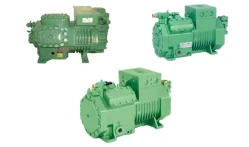Here are the key functions and components of an audio compressor
2024-01-09
A refrigeration compressor is a mechanical device that plays a crucial role in the refrigeration cycle by compressing low-pressure, low-temperature refrigerant gas and transforming it into a high-pressure, high-temperature gas. This compressed gas is then condensed, allowing heat to be released, and the refrigerant to return to a liquid state. The refrigeration cycle continues as the liquid refrigerant evaporates to absorb heat from the surroundings, completing the process of cooling or refrigeration. Here are key aspects of refrigeration compressors:
1. Types of Refrigeration Compressors:
- There are several types of compressors used in refrigeration systems, each with its own advantages and applications. Common types include reciprocating compressors, rotary compressors, scroll compressors, and centrifugal compressors.
2. Reciprocating Compressors:
- Reciprocating compressors use a piston-cylinder mechanism to compress refrigerant. The piston moves back and forth, creating a vacuum to draw in refrigerant and then compressing it when moving upward. These compressors are often used in smaller applications like household refrigerators and air conditioners.
3. Rotary Compressors:
- Rotary compressors operate with a rotating mechanism to compress refrigerant. They are known for their compact size and smooth operation. Rotary compressors are commonly found in residential and commercial air conditioning systems.
4. Scroll Compressors:
- Scroll compressors use a set of interlocking spiral scrolls to compress refrigerant. They are efficient and operate more quietly than reciprocating compressors. Scroll compressors are often used in residential and light commercial air conditioning systems.
5. Centrifugal Compressors:
- Centrifugal compressors are used in larger commercial and industrial refrigeration systems. They operate by accelerating refrigerant using a high-speed impeller. The kinetic energy is then converted into pressure as the refrigerant flows through diffusers.
6. Hermetic and Semi-Hermetic Compressors:
- Compressors can be hermetic (sealed) or semi-hermetic. Hermetic compressors have a sealed housing, while semi-hermetic compressors have a housing that can be opened for maintenance. Hermetic compressors are common in household appliances.
7. Variable Speed Compressors:
- Some modern refrigeration systems use variable speed compressors that can adjust their speed based on cooling demand. This allows for improved energy efficiency and precise temperature control.
8. Oil Lubrication:
- Compressors may require lubrication to reduce friction and wear. In systems where the refrigerant circulates through the compressor, oil separators are used to separate oil from the refrigerant before it reaches the evaporator.
9. Capacity Control:
- Refrigeration compressors often have capacity control mechanisms to modulate the amount of refrigerant they compress. This is important for matching the cooling load and increasing overall system efficiency.
10. Application Specificity:
- The choice of the compressor type depends on the specific requirements of the refrigeration application. For example, household refrigerators may use different compressors than industrial refrigeration systems.
Refrigeration compressors are integral components in various cooling systems, including air conditioners, refrigerators, freezers, and industrial refrigeration units. Their efficiency, reliability, and ability to control the refrigeration cycle play a significant role in maintaining optimal temperatures for various applications.



